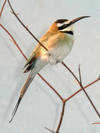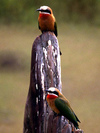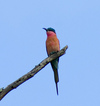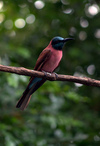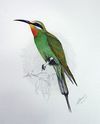Genus Merops
White-throated Bee Eater - This species, like other bee-eaters, is a richly-coloured, slender bird. It is predominantly green, but its face and throat are white with a black crown, eye stripe, and neckband. The underparts are pale green shading to blue on the breast. The eye is red and the beak is black.
European Bee Eater - This species, like other bee-eaters, is a richly-coloured, slender bird. It has brown and yellow upper parts, whilst the wings are green and the beak is black. It can reach a length of 27–29 cm , including the two elongated central tail feathers. Sexes are alike.
White-fronted Bee-eater - They have a distinctive white forehead, a square tail and a bright red patch on their throat. They nest in small colonies, digging holes in cliffs or earthen banks but can usually be seen in low trees waiting for passing insects from which they hunt either by making quick hawking flights or gliding down before hovering briefly to catch insects.
Black Bee Eater - Black with scarlet chin and throat, streaked breast, pale blue eyebrow, belly, undertail-coverts and rump, rufous primaries.
Swallow-tailed Bee-eater - This species, like other bee-eaters, is a richly coloured, slender bird. Its colours and readily visible forked tail make this species unmistakable. It is mainly green with a yellow throat, blue gorget and black eye stripe and beak. It can reach a length of 20–22 cm, including the long forked green or blue feathers. Sexes are alike.
Bay-headed Bee Eater - This species, like other bee-eaters, is a richly coloured, slender bird. It is predominantly green, with blue on the rump and lower belly. Its face and throat are yellow with a black eye stripe, and the crown and nape are rich chestnut. The thin curved bill is black. Sexes are alike, but young birds are duller.
Merops nubicoides - This species, like other bee-eaters, is a richly coloured,striking bird, predominantly carmine in colouration, but with the crown and undertail coverts blue.
Carmine Bee Eater - Its range includes most of the northern Subsaharan regions of Africa.
Green Bee-eater - The Green Bee-eater, Merops orientalis, is a near passerine bird in the bee-eater family. It is resident in a belt across sub-Saharan Africa from Senegal and The Gambia to Ethiopia, the Nile valley, western Arabia and Asia through India to Vietnam.
Australian Bee Eater - Rainbow bee-eaters are brilliantly colored birds that grow to be 7 to 8 inches in length, including the elongated tail feathers. The upper back and wings are green in color, and the lower back and under-tail coverts are bright blue. The undersides of the wings and primary flight feathers are red and tipped with black, and the tail is black to deep violet. The rainbow bee-eater's two central tail feathers are longer than the other tail feathers, and are longer in the female rainbow bee-eaters than in the males. The crown of the head, the stomach and breast, and the throat are pale yellowish in color, and the rainbow bee-eater has a black bib and a black stripe through its red eye.
Blue-cheeked Bee Eater - This species, like other bee-eaters, is a richly-coloured, slender bird. It is predominantly green; its face has blue sides with a black eye stripe, and a yellow and brown throat; the beak is black. It can reach a length of 24-26 cm, including the two elongated central tail feathers. Sexes are alike.
Blue-tailed Bee-eater - This species is sometimes considered to be conspecific with the Blue-cheeked Bee-eater, M. persicus.
Little Bee Eater - This species, like other bee-eaters, is a richly coloured, slender bird. It has green upper parts, yellow throat, black gorget, and rich brown upper breast fading to buffish ocre on the belly. The wings are green and brown, and the beak is black. It reaches a length of 15-17 cm, which makes it the smallest African bee-eater. Sexes are alike. Often silent, their call is a soft "seep".

